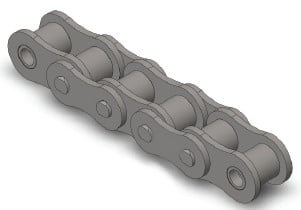Roller chains are one particular of the most productive and price eff ective approaches to transmit mechanical energy among shafts. They operate more than a wide range of speeds, handle substantial operating loads, have pretty little power losses and are usually cheap compared with other solutions
of transmitting energy. Profitable choice consists of following many fairly basic techniques involving algebraic calculation as well as the use of horsepower and service component tables.
For just about any provided set of drive conditions, there are a number of possible chain/sprocket confi gurations that will successfully operate. The designer consequently really should be conscious of numerous fundamental variety rules that when applied appropriately, assistance balance total drive performance and price. By following the methods outlined on this part designers should be in a position to create choices that meet the requirements in the drive and therefore are cost eff ective.
General Roller Chain Drive Concepts
? The advisable variety of teeth to the smaller sprocket is 15. The minimal is 9 teeth – smoother operation is obtained with a lot more teeth.
? The advised optimum number of teeth for your big sprocket is 120. Note that even though additional teeth lets for smoother operation obtaining too several teeth leads to chain jumping off the sprocket just after a reasonably modest amount of chain elongation on account of put on – That may be chains with a quite substantial variety of teeth accommodate less dress in prior to the chain will no longer wrap about them adequately.
? Speed ratios needs to be seven:1 or much less (optimum) and not higher
than ten:one. For more substantial ratios using several chain reductions is advised.
? The suggested minimum wrap of the little sprocket is 120°.
? The advisable center distance concerning shafts is 30-50 pitches of chain. You will find two exceptions to this as follows:
1. The center distance should be better compared to the sum of the outside diameters with the driver and driven sprockets  to prevent interference.
to prevent interference.
2. For pace ratios greater than three:1 the center distance should not be less than the outdoors diameter with the substantial sprocket minus the outside diameter on the modest sprocket to assure a minimal 120° wrap around the small sprocket.
